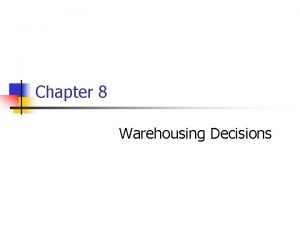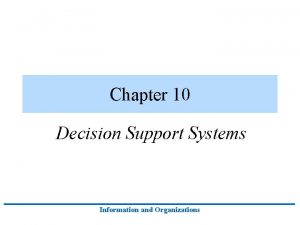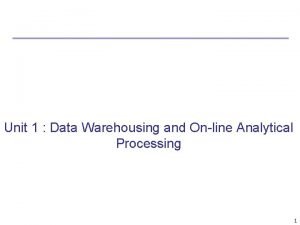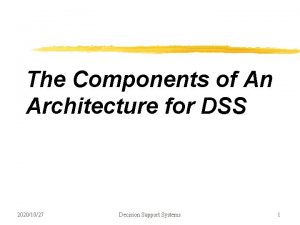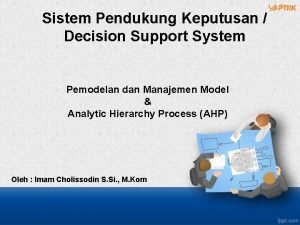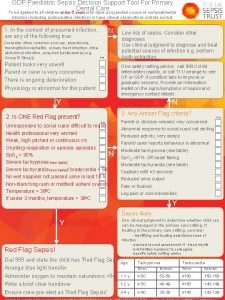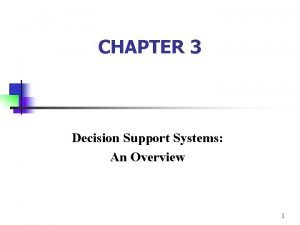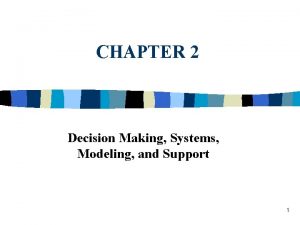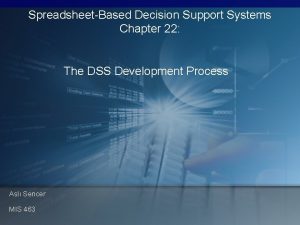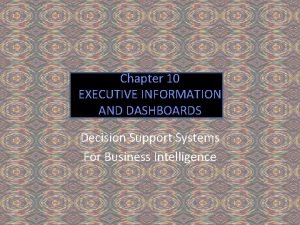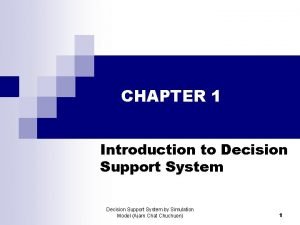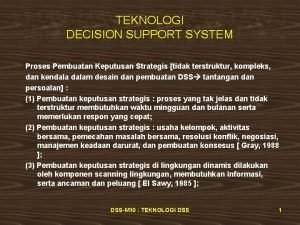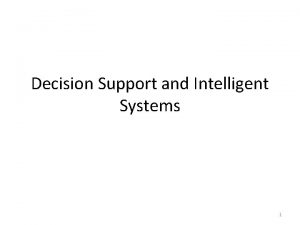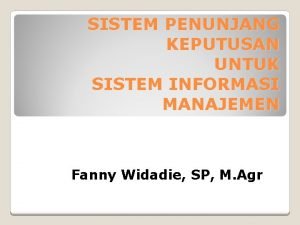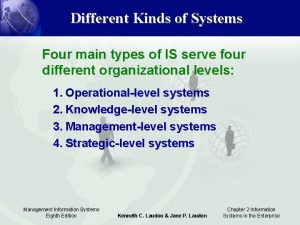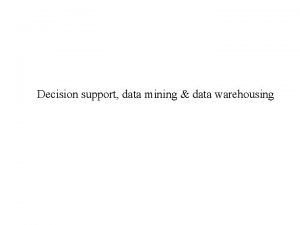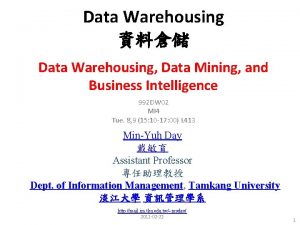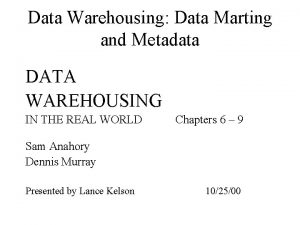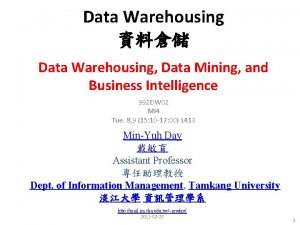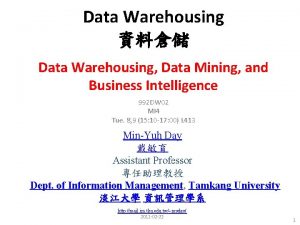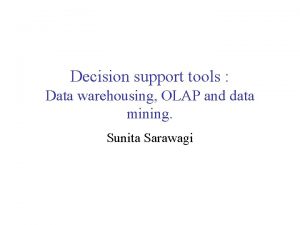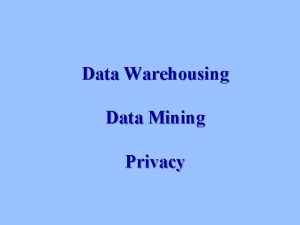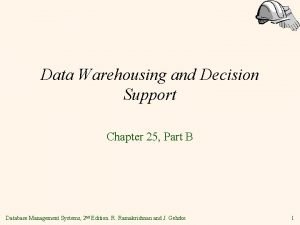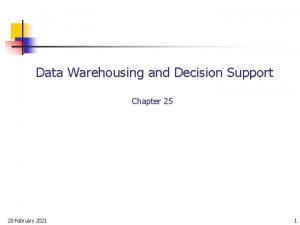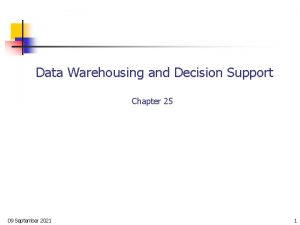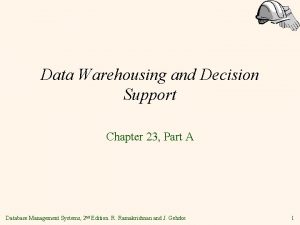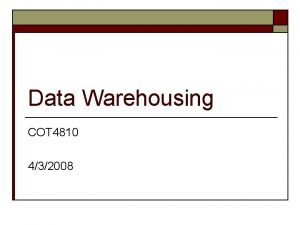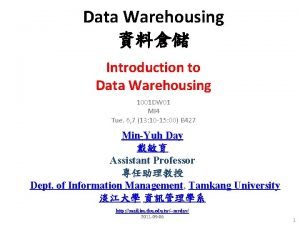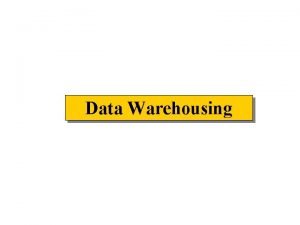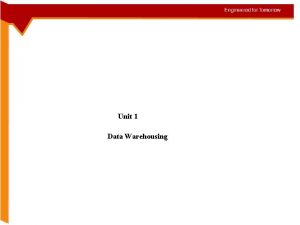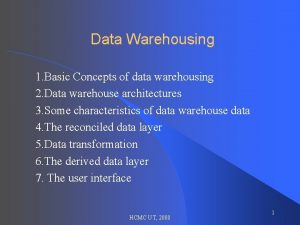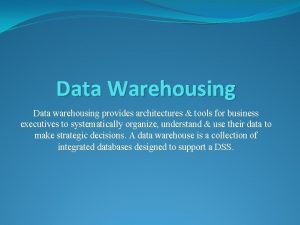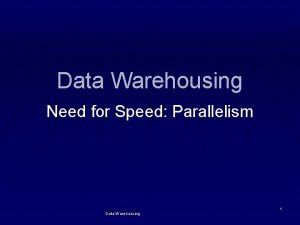Data Warehousing and Decision Support 1 Data Warehousing





















































- Slides: 53

Data Warehousing and Decision Support 1

Data Warehousing and OLAP Technology n What is a data warehouse? n A multi-dimensional data model n Data warehouse architecture n Data warehouse implementation n Further development of data cube technology n From data warehousing to data mining 2

What is Data Warehouse? n n n Defined in many different ways, but not rigorously. n A decision support database that is maintained separately from the organization’s operational database n Supports information processing by providing a solid platform of consolidated, historical data for analysis. “A data warehouse is a subject-oriented, integrated, time -variant, and nonvolatile collection of data in support of management’s decision-making process. ”—W. H. Inmon Data warehousing: n The process of constructing and using data warehouses 3

Data Warehouse—Subject-Oriented n Organized around major subjects, such as customer, product, sales. n Focusing on the modeling and analysis of data for decision makers, not on daily operations or transaction processing. n Provide a simple and concise view around particular subject issues by excluding data that are not useful in the decision support process. 4

Data Warehouse—Integrated n n Constructed by integrating multiple, heterogeneous data sources n relational databases, flat files, on-line transaction records Data cleaning and data integration techniques are applied. n Ensure consistency in naming conventions, encoding structures, attribute measures, etc. among different data sources n n E. g. , Hotel price: currency, tax, breakfast covered, etc. When data is moved to the warehouse, it is converted. 5

Data Warehouse—Time Variant n The time horizon for the data warehouse is significantly longer than that of operational systems. n n n Operational database: current value data. Data warehouse data: provide information from a historical perspective (e. g. , past 5 -10 years) Every key structure in the data warehouse n n Contains an element of time, explicitly or implicitly But the key of operational data may or may not contain “time element”. 6

Data Warehouse—Non-Volatile n A physically separate store of data transformed from the operational environment. n Operational update of data does not occur in the data warehouse environment. n Does not require transaction processing, recovery, and concurrency control mechanisms n Requires only two operations in data accessing: n initial loading of data and access of data. 7

Data Warehouse vs. Heterogeneous DBMS n Traditional heterogeneous DB integration: n Build wrappers/mediators on top of heterogeneous databases n Query driven approach n n When a query is posed to a client site, a meta-dictionary is used to translate the query into queries appropriate for individual heterogeneous sites involved, and the results are integrated into a global answer set Data warehouse: update-driven, high performance n Information from heterogeneous sources is integrated in advance and stored in warehouses for direct query and analysis 8

Data Warehouse vs. Operational DBMS n OLTP (on-line transaction processing) n n Major task of traditional relational DBMS Day-to-day operations: purchasing, inventory, banking, manufacturing, payroll, registration, accounting, etc. OLAP (on-line analytical processing) n Major task of data warehouse system n Data analysis and decision making Distinct features (OLTP vs. OLAP): n User and system orientation: customer vs. market n Data contents: current, detailed vs. historical, consolidated n Database design: ER + application vs. star + subject n View: current, local vs. evolutionary, integrated n Access patterns: update vs. read-only but complex queries 9

OLTP vs. OLAP 10

Why Separate Data Warehouse? n n High performance for both systems n DBMS— tuned for OLTP: access methods, indexing, concurrency control, recovery n Warehouse—tuned for OLAP: complex OLAP queries, multidimensional view, consolidation. Different functions and different data: n missing data: Decision support requires historical data which operational DBs do not typically maintain n data consolidation: DS requires consolidation (aggregation, summarization) of data from heterogeneous sources n data quality: different sources typically use inconsistent data representations, codes and formats which have to be reconciled 11

Chapter 2: Data Warehousing and OLAP Technology for Data Mining n What is a data warehouse? n A multi-dimensional data model n Data warehouse architecture n Data warehouse implementation n Further development of data cube technology n From data warehousing to data mining 12

Conceptual Modeling of Data Warehouses n Modeling data warehouses: dimensions & measures n Star schema: A fact table in the middle connected to a set of dimension tables n Snowflake schema: A refinement of star schema where some dimensional hierarchy is normalized into a set of smaller dimension tables, forming a shape similar to snowflake n Fact constellations: Multiple fact tables share dimension tables, viewed as a collection of stars, therefore called galaxy schema or fact constellation 13

Example of Star Schema time item time_key day_of_the_week month quarter year Sales Fact Table time_key item_key branch_key branch_name branch_type location_key units_sold dollars_sold avg_sales item_key item_name brand type supplier_type location_key street city province_or_street country Measures 14

Example of Snowflake Schema time_key day_of_the_week month quarter year item Sales Fact Table time_key item_key branch location_key branch_name branch_type units_sold dollars_sold avg_sales Measures item_key item_name brand type supplier_key supplier_type location_key street city_key city province_or_street country 15

Example of Fact Constellation time_key day_of_the_week month quarter year item Sales Fact Table time_key item_key item_name brand type supplier_type location_key branch_name branch_type units_sold dollars_sold avg_sales Measures time_key item_key shipper_key from_location branch_key branch Shipping Fact Table location to_location_key street city province_or_street country dollars_cost units_shipped shipper_key shipper_name location_key shipper_type 16

A Concept Hierarchy: Dimension (location) all Europe region country city office Germany Frankfurt . . Spain North_America Canada Vancouver. . . L. Chan . . . Mexico Toronto M. Wind 18

From Tables and Spreadsheets to Data Cubes n n A data warehouse is based on a multidimensional data model which views data in the form of a data cube A data cube, such as sales, allows data to be modeled and viewed in multiple dimensions n n n Dimension tables, such as item (item_name, brand, type), or time(day, week, month, quarter, year) Fact table contains measures (such as dollars_sold) and keys to each of the related dimension tables In data warehousing literature, an n-D base cube is called a base cuboid. The top most 0 -D cuboid, which holds the highest-level of summarization, is called the apex cuboid. The lattice of cuboids forms a data cube. 20

Multidimensional Data Sales volume as a function of product, month, and region Dimensions: Product, Location, Time Hierarchical summarization paths gi on n Re Industry Region Year Product Category Country Quarter Product City Office Month Week Day Month 21

Pr od TV PC VCR sum 1 Qtr 2 Qtr Date 3 Qtr 4 Qtr Total annual sales sum of TV in U. S. A Canada Mexico Country uc t A Sample Data Cube sum 22

Cuboids Corresponding to the Cube all 0 -D(apex) cuboid product, date country product, country 1 -D cuboids date, country 2 -D cuboids product, date, country 3 -D(base) cuboid 23

Browsing a Data Cube n n n Visualization OLAP capabilities Interactive manipulation 24

Typical OLAP Operations n Roll up (drill-up): summarize data n n Drill down (roll down): reverse of roll-up n n project and select Pivot (rotate): n n from higher level summary to lower level summary or detailed data, or introducing new dimensions Slice and dice: n n by climbing up hierarchy or by dimension reduction reorient the cube, visualization, 3 D to series of 2 D planes. Other operations n n drill across: involving (across) more than one fact table drill through: through the bottom level of the cube to its backend relational tables (using SQL) 25

Chapter 2: Data Warehousing and OLAP Technology for Data Mining n What is a data warehouse? n A multi-dimensional data model n Data warehouse architecture n Data warehouse implementation n Further development of data cube technology n From data warehousing to data mining 26

Multi-Tiered Architecture other Metadata sources Operational DBs Extract Transform Load Refresh Monitor & Integrator Data Warehouse OLAP Server Serve Analysis Query Reports Data mining Data Marts Data Sources Data Storage OLAP Engine Front-End Tools 27

OLAP Server Architectures n n Relational OLAP (ROLAP) n Use relational or extended-relational DBMS to store and manage warehouse data and OLAP middleware n Include optimization of DBMS backend, implementation of aggregation navigation logic, and additional tools and services n greater scalability Multidimensional OLAP (MOLAP) n Array-based multidimensional storage engine (sparse matrix techniques) n fast indexing to pre-computed summarized data Hybrid OLAP (HOLAP) n User flexibility, e. g. , low level: relational, high-level: array Specialized SQL servers n specialized support for SQL queries over star/snowflake schemas 30

Chapter 2: Data Warehousing and OLAP Technology for Data Mining n What is a data warehouse? n A multi-dimensional data model n Data warehouse architecture n Data warehouse implementation n Further development of data cube technology n From data warehousing to data mining 31

Efficient Data Cube Computation n Data cube can be viewed as a lattice of cuboids n The bottom-most cuboid is the base cuboid n The top-most cuboid (apex) contains only one cell n How many cuboids in an n-dimensional cube? 32

Problem: How to Implement Data Cube Efficiently? n Physically materialize the whole data cube n n n Materialize nothing n n Space consuming in storage and time consuming in construction Indexing overhead No extra space needed but unacceptable response time Materialize only part of the data cube n n n Intuition: precompute frequently-asked queries? However: each cell of data cube is an aggregation, the value of many cells are dependent on the values of other cells in the data cube A better approach: materialize queries which can help answer many other queries quickly 33

An motivating example n n Assume the data cube: n Stored in a relational DB (MDDB is not very scalable) n Different cuboids are assigned to different tables n The cost of answering a query is proportional to the number of rows examined Use TPC-D decision-support benchmark n Attributes: part, supplier, and customer n Measure: total sales n 3 -D data cube: cell (p, s , c) 34

An motivating example (cont. ) n Hypercube lattice: the eight views (cuboids) constructed by grouping on some of part, supplier, and customer Finding total sales grouped by part Processing 6 million rows if cuboid pc is materialized n Processing 0. 2 million rows if cuboid p is materialized n Processing 0. 8 million rows if cuboid ps is materialized n 35

An motivating example (cont. ) How to find a good set of views? n How many views must be materialized to get reasonable performance? n Given space S, what views should be materialized to get the minimal average query cost? n If we are willing to tolerate an X% degradation in average query cost from a fully materialized data cube, how much space can we save over the fully materialized data cube? 36

Dependence relation The dependence relation on queries: n Q 1 _ Q 2 iff Q 1 can be answered using only the results of query Q 2 (Q 1 is dependent on Q 2). In which n _ is a partial order, and n There is a top element, a view upon which all queries are dependent (base cuboid) n Example: n (part) _ (part, customer) n (part) _ (customer) and (customer) _ (part) 37

Lattice notation n n n A lattice with set of elements L and dependance relation _ is denoted by <L, _> a b means that a _ b, and a ¹ b ancestor(a) = {b | a _ b } descendant(a) = {b | b _ a } next(a) = {b | a b, $ c, a c , c b} Lattice diagrams: a lattice can be represented as a graph, where the lattice elements (views) are nodes and there is an edge from a below b iff b is in next(a). 38

The advantages of lattice framework n n n Provide a clean framework to reason with dimensional hierarchies We can model the common queries asked by users better Tells us in what order to materialize the views 43

The linear cost model n For <L, _>, Q _ QA, C(Q) is the number of rows required to construct Q in QA n n Assume all queries are full views: i. e. , identical to some element (view) in the given lattice T=m*S+c (m: time/size ratio; c: query overhead; S can be estimated by sampling and analytical methods) 44

The benefit of a materialized view n n n Denote the benefit of a materialized view v, relative to some set of views S, as B(v, S) For each w _ v, define BW by: n Let C(v) be the cost of view v n Let u be the view of least cost in S such that w _ u (such S must exist) n BW = C(u) – C(v) if C(v) < C(u) =0 if C(v) ≥ C(u) n BW is the benefit that it can obtain from v Define B(v, S) = Σ w < v Bw, means how v can improve the cost of evaluating views, including itself 45

The greedy algorithm n Objective n Assume materializing a fixed number of views, regardless of the space they use n How to minimize the average time taken to evaluate a view? The greedy algorithm for materializing a set of k views n Performance: Greedy/Optimal ≥ 1 – (1 – 1/k) k ≥ (e - 1) / e n 46

Greedy algorithm example 1 n Suppose we want to choose three views (k = 3) n The selection is optimal (reduce cost from 800 to 420) 47

Greedy algorithm example 2 n Suppose k = 2 n Greedy algorithm picks c and b, benefit = 101*41+100*21 = 6241 n Optimal selection is b and d benefit = 100*41+100*41 = 8200 n However, greedy/optimal = 6241/8200 > 3/4 48

An experiment: how many views should be materialized? n Time and space for the greedy selection for the TPC-Dbased example (full materialization is not efficient) Number of materialized views 49

Efficient Processing of OLAP Queries n Determine which operations should be performed on the available cuboids: n transform drill, roll, etc. into corresponding SQL and/or OLAP operations, e. g, dice = selection + projection n Determine to which materialized cuboid(s) the relevant operations should be applied. n Exploring indexing structures and compressed vs. dense array structures in MOLAP 52

Metadata Repository n Meta data is the data defining warehouse objects. It has the following kinds n Description of the structure of the warehouse n n Operational meta-data n n data lineage (history of migrated data and transformation path), currency of data (active, archived, or purged), monitoring information (warehouse usage statistics, error reports, audit trails) The algorithms used for summarization The mapping from operational environment to the data warehouse Data related to system performance n n schema, view, dimensions, hierarchies, derived data defn, data mart locations and contents warehouse schema, view and derived data definitions Business data n business terms and definitions, ownership of data, charging policies 53

Data Warehouse Back-End Tools and Utilities n Data extraction: n n Data cleaning: n n convert data from legacy or host format to warehouse format Load: n n detect errors in the data and rectify them when possible Data transformation: n n get data from multiple, heterogeneous, and external sources sort, summarize, consolidate, compute views, check integrity, and build indicies and partitions Refresh n propagate the updates from the data sources to the warehouse 54

Chapter 2: Data Warehousing and OLAP Technology for Data Mining n What is a data warehouse? n A multi-dimensional data model n Data warehouse architecture n Data warehouse implementation n Further development of data cube technology n From data warehousing to data mining 55

Discovery-Driven Exploration of Data Cubes n Hypothesis-driven: exploration by user, huge search space n Discovery-driven (Sarawagi et al. ’ 98) n pre-compute measures indicating exceptions, guide user in the data analysis, at all levels of aggregation n Exception: significantly different from the value anticipated, based on a statistical model n Visual cues such as background color are used to reflect the degree of exception of each cell n Computation of exception indicator (modeling fitting and computing Self. Exp, In. Exp, and Path. Exp values) can be overlapped with cube construction 56

Examples: Discovery-Driven Data Cubes 57

Complex Aggregation at Multiple Granularities: Multi-Feature Cubes n n Multi-feature cubes (Ross, et al. 1998): Compute complex queries involving multiple dependent aggregates at multiple granularities Ex. Grouping by all subsets of {item, region, month}, find the maximum price in 1997 for each group, and the total sales among all maximum price tuples select item, region, month, max(price), sum(R. sales) from purchases where year = 1997 cube by item, region, month: R such that R. price = max(price) n Continuing the last example, among the max price tuples, find the min and max shelf life, and find the fraction of the total sales due to tuple that have min shelf life within the set of all max price tuples 58

Chapter 2: Data Warehousing and OLAP Technology for Data Mining n What is a data warehouse? n A multi-dimensional data model n Data warehouse architecture n Data warehouse implementation n Further development of data cube technology n From data warehousing to data mining 59

Data Warehouse Usage n Three kinds of data warehouse applications n Information processing n n n Analytical processing n multidimensional analysis of data warehouse data n supports basic OLAP operations, slice-dice, drilling, pivoting Data mining n n n supports querying, basic statistical analysis, and reporting using crosstabs, tables, charts and graphs knowledge discovery from hidden patterns supports associations, constructing analytical models, performing classification and prediction, and presenting the mining results using visualization tools. Differences among the three tasks 60

From On-Line Analytical Processing to On Line Analytical Mining (OLAM) n Why online analytical mining? n n n High quality of data in data warehouses n DW contains integrated, consistent, cleaned data Available information processing structure surrounding data warehouses n ODBC, OLEDB, Web accessing, service facilities, reporting and OLAP tools OLAP-based exploratory data analysis n mining with drilling, dicing, pivoting, etc. On-line selection of data mining functions n integration and swapping of multiple mining functions, algorithms, and tasks. Architecture of OLAM 61

An OLAM Architecture Mining query Mining result Layer 4 User Interface User GUI API OLAM Engine OLAP Engine Layer 3 OLAP/OLAM Data Cube API Layer 2 MDDB Meta Data Filtering&Integration Database API Filtering Layer 1 Databases Data cleaning Data integration Warehouse Data Repository 62

Summary n Data warehouse n n n A multi-dimensional model of a data warehouse n Star schema, snowflake schema, fact constellations n A data cube consists of dimensions & measures OLAP operations: drilling, rolling, slicing, dicing and pivoting OLAP servers: ROLAP, MOLAP, HOLAP Efficient computation of data cubes n n A subject-oriented, integrated, time-variant, and nonvolatile collection of data in support of management’s decision-making process Partial vs. full vs. no materialization Multiway array aggregation Bitmap index and join index implementations Further development of data cube technology n n Discovery-drive and multi-feature cubes From OLAP to OLAM (on-line analytical mining) 63
 Objectives of decision making
Objectives of decision making Dividend decision in financial management
Dividend decision in financial management Operational data vs decision support data
Operational data vs decision support data Warehousing decisions
Warehousing decisions What is kdd process in data mining
What is kdd process in data mining Mining fraud
Mining fraud Olap database
Olap database Introduction to data warehousing and data mining
Introduction to data warehousing and data mining Hive
Hive Best practices data warehousing
Best practices data warehousing Decision tree and decision table
Decision tree and decision table Decision support systems and intelligent systems
Decision support systems and intelligent systems Group decision support and groupware technologies
Group decision support and groupware technologies Decision support and business intelligence systems
Decision support and business intelligence systems Decision support system advantages and disadvantages
Decision support system advantages and disadvantages Decision support and business intelligence systems
Decision support and business intelligence systems An expert system is
An expert system is Expert system and decision support system
Expert system and decision support system Decision support and expert systems
Decision support and expert systems An overview of data warehousing and olap technology
An overview of data warehousing and olap technology An overview of data warehousing and olap technology
An overview of data warehousing and olap technology Starnet query model in data warehouse
Starnet query model in data warehouse Example of major points
Example of major points 5 types of information system
5 types of information system Architecture of dss
Architecture of dss Contoh spk motor honda
Contoh spk motor honda Navify decision support
Navify decision support Gdp sepsis decision support tool
Gdp sepsis decision support tool Components of decision support system
Components of decision support system Components of group decision support system
Components of group decision support system Data management subsystem in dss
Data management subsystem in dss Components of decision support system
Components of decision support system Types of decision support system
Types of decision support system Developing spreadsheet-based decision support systems
Developing spreadsheet-based decision support systems Model driven decision support system
Model driven decision support system Decision support system in knowledge management
Decision support system in knowledge management Iliad clinical decision support system
Iliad clinical decision support system Purpose of enterprise decision support system
Purpose of enterprise decision support system Objectives of decision support system
Objectives of decision support system Chapter 10
Chapter 10 Decision chapter 1
Decision chapter 1 Proses decision support system
Proses decision support system Knowledge based decision support system
Knowledge based decision support system Benefits of decision support system
Benefits of decision support system Mdss in marketing
Mdss in marketing Voyage estimating decision support system
Voyage estimating decision support system Business intelligence evolution
Business intelligence evolution Business intelligence framework
Business intelligence framework Voyage estimating decision support system
Voyage estimating decision support system Maintenance decision support system
Maintenance decision support system Isabel clinical decision support
Isabel clinical decision support The time/space collaboration and social tool matrix
The time/space collaboration and social tool matrix Voyage estimating decision support system
Voyage estimating decision support system Wfdss training
Wfdss training



